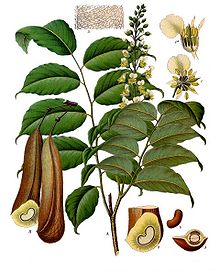- Myroxylon
-
Myroxylon J.R.Forst. & G.Forst is a synonym of Xylosma.
Myroxylon 
Myroxylon balsamum from Koehler's Medicinal-Plants (1887) Scientific classification Kingdom: Plantae (unranked): Angiosperms (unranked): Eudicots (unranked): Rosids Order: Fabales Family: Fabaceae Subfamily: Faboideae Tribe: Sophoreae Genus: Myroxylon
L.f.Species Myroxylon balsamum
Myroxylon peruiferum[1]Myroxylon is a genus of two species of Central American and South American trees in the Fabaceae (Leguminosae). The tree is well known in the western world as the source for Peru balsam and Tolu balsam. The tree is often called Quina or Balsamo. Other names include Tolu in Colombia, Quina quina in Argentina; in lumber trade, sometimes named Santos Mahogany.
Its sweetish scent, reminiscent of vanilla and green olives, has caused it to be used in the manufacture of perfumes as a source for Balsam. Balsam of Peru is used as a flavoring and fragrance in many products and can cause allergic reactions.[2]
They are large trees growing to 40 m tall, with evergreen pinnate leaves 15 cm long with 5-13 leaflets. The flowers are white with yellow stamens, produced in racemes. The fruit is a pod 7–11 cm long, containing a single seed.[3]
The wood is dark brown with a deep red heartwood. Natural oils grant it excellent decay resistance. In fact, it is also resistant to preservative treatment. Its specific gravity is 0.74 to 0.81.
As regards woodworking, this tree is regarded as moderately difficult to work but can be finished with a high natural polish; some tool dulling.
Peru Balsam
Peru Balsam aromatic resin is extracted from the variant Myroxylon balsamum pereirae, native from Central America farther north. The name is a misinterpretation of its origin, since it was originally assembled and shipped to Europe from the ports of Callao and Lima, in Peru, even though the species is not indigenous to Peru. The indigenous use of Peru Balsam led to its export to Europe in the seventeenth century, where it was first documented in the German Pharmacopedia. Today El Salvador is the main exporter of Peru Balsam where it is extracted under a plainly handicraft process[4]
Peru balsam has uses in medicine, pharmaceutical, in the food industry and in perfumery. It has been used as a cough supressant, in the treatment of dry socket in dentistry, in suppositories for hemorrhoids, the plants have been reported to inhibit Mycobacterium tuberculosis as well as the common ulcer-causing bacteria, H. pylori in test-tube studies, so it is used topically as a treatment of wounds and ulcers, as an antiseptic and used as an anal muscle relaxant. Peru Balsam can be found in diaper rash ointments, hair tonics, antidandruff preparations, and feminine hygiene sprays and as a natural fragrance in soaps, detergents, creams, lotions, and perfumes.[4][5]
Invasive Species
The balsam tree can become a highly invasive species when introduced into tropical countries where it is not native. In Sri Lanka it has overgrown several hectares of the Udawatta Kele Sanctuary and is rapidly spreading there.[6][7][8] In this Sri Lankan rain forest, Myroxylon seeds sprout in very high numbers due to tolerating more diverse light conditions than native species and due to the absence of natural enemies such as diseases and insects. This has given rise to dense stands of young trees where no other vegetation can grow, causing severe ecological disruption, i.e., the disappearance of local, native plant species and consequently of the animals and insects that feed on these.[9]
The tree has also been introduced to several Pacific islands such as Fiji and to Indonesia and is a potential ecological threat there.[3]
References
- ^ ILDIS Version 6.05
- ^ "Balsam of Peru induced contact allergy" DermatitisFacts.com. Date of publication: Unknown. Accessed: October 11, 2007
- ^ a b "Pacific Island Ecosystems at Risk: Myroxylon balsamum". PIER. http://www.hear.org/gcw/species/myroxylon_balsamum. Retrieved 2010-03-15.
- ^ a b http://www.riverabalsam.com
- ^ http://www.drugs.com/npp/peru-balsam.html
- ^ "'W. De Costa, H. Hitanayake and I. Dharmawardena, "A Physiological Investigation into the Invasive Behaviour of Some Plant Species in a Mid-Country Forest Reserve in Sri Lanka"". JNSFSL, 2001, 29 (1 & 2):35–50. http://thakshana.nsf.ac.lk/pdf/JNSF26-34/JNSF29_1&2/JNSF29_1&2_35.pdf. Retrieved 2010-03-15.
- ^ Pushpakumara, D.K.N.G. and Hitinayake, H.M.G.S.B. (2001). Invasive Tree Species in Udawattekele Forest Reserve. Sri Lankan Biodiversity Review, Volume 1: 53-63.
- ^ Pallawatta, Nirmalie/Reaser, Jamie K./Gutierrez, Alixis T./eds. 2003. Invasive alien species in south-southeast Asia: national reports and directory of resources. Global Invasive Species Programme.
- ^ "H. P. Wedathanthri and H.M.G.S.B. Hitinayake, "Invasive Behaviour of Myroxylon balsamum at Udawattakele Forest Reserve"". Forestry and Environment Symposium 1999, Sri Lanka. http://forestry1999.blogspot.com/2006/10/invasive-behaviour-of-myroxylon.html. Retrieved 2010-03-15.
Categories:
Wikimedia Foundation. 2010.

